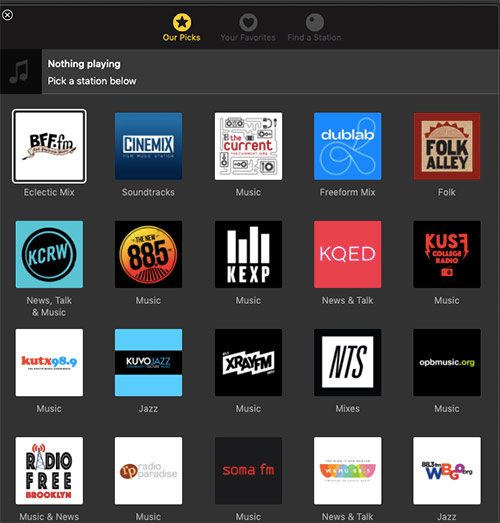Back in June I openly worried about the future state of internet radio on the Mac with the arrival of macOS Catalina and the demise of iTunes. While iTunes has its faults, it still provided a simple way to tune in stations from around the world without using a web browser, whether you found the station in its own directory or plugged in the station’s stream URL yourself.
I’m happy to report that the situation is not as dire as I’d feared.
An early release of the Music app on both MacOS and iOS featured only a handful of carefully chosen stations outside of Beats 1 Radio and Apple’s own curated stations, the latter only available with a paid Apple Music subscription. However, now the Music app now gives you access to a very comprehensive selection of both terrestrial and pure-play internet stations across the U.S. and from around the world.
This is very good news, though Music isn’t yet a full-fledged iTunes replacement. The first big difference is that the Music app doesn’t really let you browse the world of internet radio. Sure, there’s a “Radio” button in the menu, but what you get is mostly populated by Beats 1 and Apple Music stations, along with a smattering of big public and commercial stations. Scroll down and you see a menu item, “Radio Stations,” that seems promising. But click on it and you just get more featured Apple Music stations, along with a list of genres that – you guessed it – deliver even more Apple Music stations.
The Vagaries of the Search
So where are all the real internet radio stations? Search, you must, young Jedi.
Indeed, I was able to find pretty much every station on my local Portland, Oregon radio dial. When I surveyed other Mac internet radio apps earlier this year, I discovered that stations owned by either iHeart or Entercom were often missing. That’s because these two radio giants have started pulling their stations off rival apps. iHeart only wants you to hear its stations on iHeartRadio and Entercom only wants you to hear its stations through Radio.com.
The Music app solves this problem by plugging into the iHeartRadio, Radio.com and TuneIn directories. At least in the U.S., when combined, these directories cover just about every broadcast station that has a live stream, as well as most internet stations that wish to be found. When you search for a specific station, the app displays what directory the result came from.
But search has serious limits. When I searched for “college radio” it returned only about 40 results. Included were ESPN College Football and some other results that indicate the search was only performed on station names. If you were hoping to find your local college station but don’t remember the call letters, you’re likely out of luck.
The same thing was true when searching for jazz or heavy metal. All is good if the genre is in the station’s name, but otherwise you’ll only see a small percentage of stations that might otherwise qualify.
This is curious, because all three directories Music relies on do classify stations by category or genre. The metadata is in there, but Music doesn’t search it. Combined with the inability to browse internet radio stations, this makes Music a poor way to discover internet radio stations.
Still, if you know a station’s call letter or name and its in the iHeart Radio.com or TuneIn directory – a pretty good chance – then the app is a fine way to listen to internet radio without a browser. In fact, if this is your use case, because it combines these three different directories, Music is your best choice for a desktop internet radio app.
Triode – a Promising iTunes Replacement?
I was reminded to check back in on this topic because I just learned about a new internet radio app for MacOS, iOS and tvOS. MacStories positively reviewed this app, Triode, calling it, “an excellent addition across nearly the full range of Apple’s platforms.”
I excitedly tried it out, only to run into the same limitations that hamper the other apps I surveyed: no stations from iHeart or Entercom. On the one hand, as a lover of great non-commercial stations and strange, eclectic internet radio, this isn’t necessarily a huge restriction.
I was immediately impressed with Triode on startup, as it displayed a wonderful selection of truly great independent terrestrial and internet stations, including San Francisco’s BFF.fm and SomaFM, Denver’s jazz KUVO, New Jersey’s WFMU, The Current from Minnesota Public Radio and Radio Survivor affiliate XRAY.fm here in Portland. It’s wonderful to see these recommendations rather than just a pile of big city, highly rated commercial and public stations.

When I searched for “college radio” I got back dozens upon dozens of results – more than I had the patience to count. Same for metal, jazz and blues. Clearly, Triode is searching station descriptions, categories and genres, not just names.
If you don’t find a station in the directory you can add it to Triode if you know the stream URL. Now that’s very iTunes-live behavior.
Nevertheless, I suspect that the lack of big U.S. commecial stations is a drawback that will make this more of a niche app rather than a true competitor for Apple’s own Music app. Radio nerds who love independent stations and don’t want to pick through Apple’s subscription-only offerings to find their favorites are the target audience.
While Triode is free, you can only save stations as favorites with a paid subscription for 99 cents a month, $9.99 a year or $19.99 for a forever plan. By comparison, this is a feature you get for free with TuneIn as long as you’re willing to set up a free account. Plus you’ll get access to pretty much the same catalog of stations. A Triode paid subscription also delivers high resolution album art displayed for each track, a feature whose utility holds little appeal for me.
Consolidation Is To Blame
Now, the limits of Triode’s directory aren’t the fault of the app developer. The guilty parties are iHeartRadio and Entercom, two of the largest radio companies in the U.S. which also don’t want their stations found outside their own app platforms.
Of course you can still listen to these stations on your computer… for now. Ultimately it’s consolidation that keeps independent radio apps from having access to these companies’ streams. Luckily, there are still thousands upon thousands of smaller and independent stations more than happy to be found and streamed through whatever app you might be using.
The situation parallels what we’re seeing in video streaming. Where just a few years ago you might only need to use one or two apps or subscription services – like Netflix and Hulu – to get a pretty wide variety of movies and programs, now you need like six or seven.
I’d hate to see other radio companies follow iHeart’s and Entercom’s lead and set up their own closed app platforms, requiring a listener to have five or six different apps installed just to hear all the stations on their local dial. It could be enough to drive folks away from internet radio.
Or maybe just drive them to their trusty terrestrial radio receiver, which already gets all these stations.
If only their smartphones had a plain old radio tucked inside….



